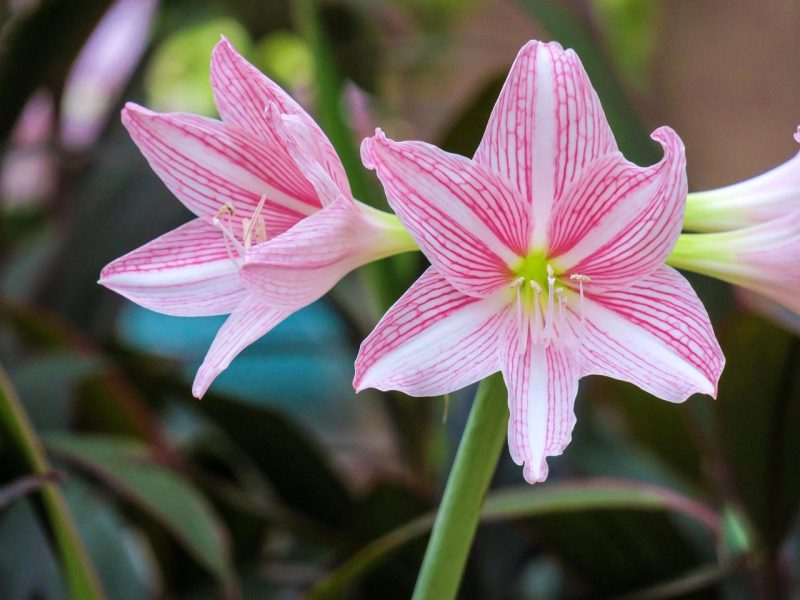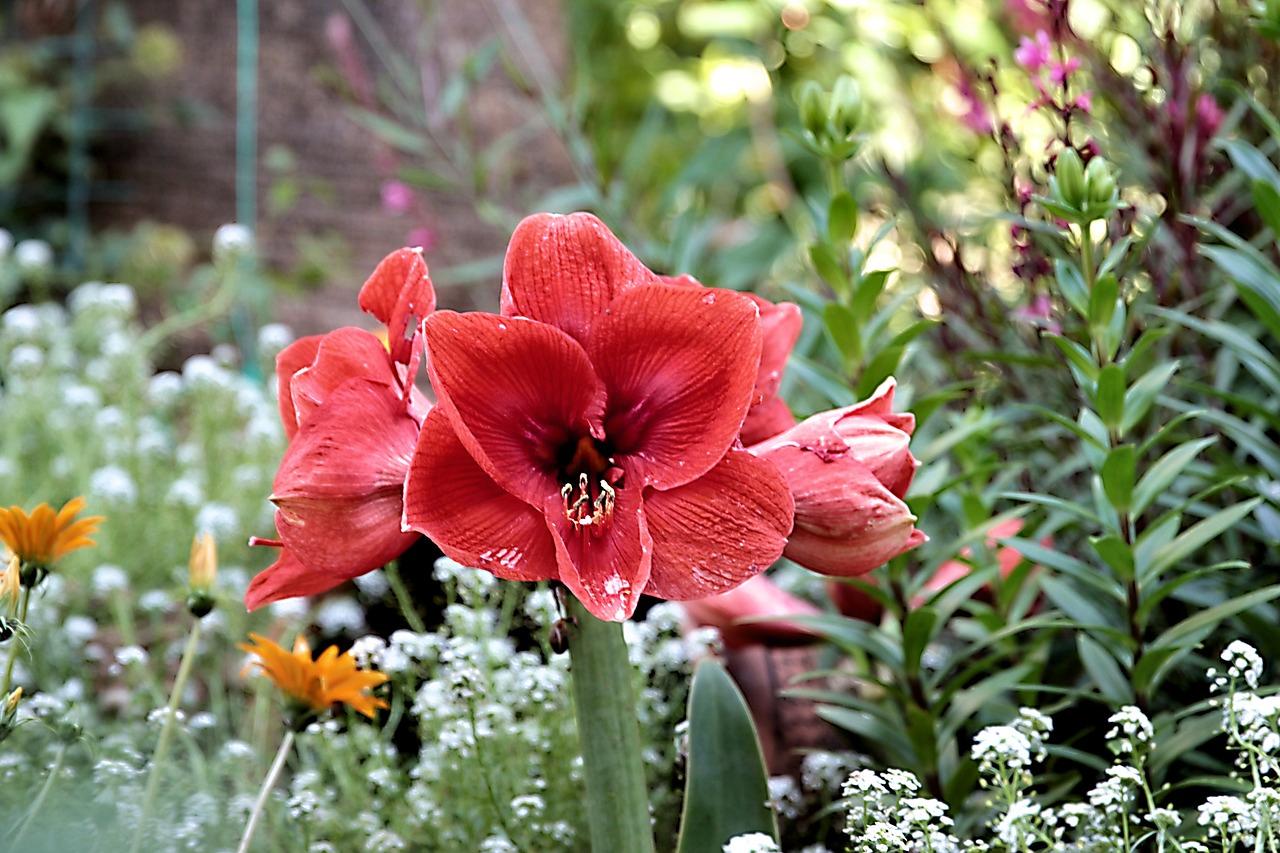Various amaryllis species, particularly Hippeastrum, are celebrated for their striking trumpet-shaped flowers that bloom in a spectrum of colors including red, pink, white, and orange.
Typically grown indoors, many enthusiasts wonder—can amaryllis be planted outside? This comprehensive guide explores this question, providing insights on cultivation, climate requirements, and best practices to ensure healthy growth.
Understanding the Amaryllis Plant
Botanical Background

Amaryllis belongs to the family Amaryllidaceae and encompasses various species and hybrids, particularly known for Hippeastrum hybrids in horticulture. Originating from tropical and subtropical regions of the Americas, these plants thrive in warmer climates, which profoundly influences their growth patterns and suitability for outdoor planting.
Growth Cycle
Amaryllis undergoes a distinct growth cycle:
Dormancy: After flowering, typically in late spring, the plant enters a dormancy phase. During this time, the leaves may die back, but the bulb remains alive and stores energy for the next growing season.
New Growth: With the right conditions (light, warmth, and moisture), the bulb will sprout new leaves and flower stalks.
Blooming: The flowering phase usually occurs in late winter to early spring when the plant receives adequate sunlight and care.
General Care
When caring for amaryllis, certain factors need to be addressed:
Watering: After planting, water thoroughly, allowing the soil to dry slightly between waterings.
Light: Amaryllis thrives in bright, indirect sunlight. Direct sunlight, particularly in hot regions, can scorch the leaves.
Fertilization: During the growing season, a balanced fertilizer can encourage robust growth and flowering.
Can Amaryllis Be Planted Outside?

The short answer is: yes, amaryllis can be planted outside, but with conditions that need to be met for successful growth. Here’s a deeper look into the factors influencing outdoor planting.
1. Climate Compatibility
Amaryllis is best suited for USDA hardiness zones 8 and above. In these climates, winter temperatures typically do not drop below 10°F (-12°C).
Warmer Climates: If you live in areas with mild winters, particularly in the southern U.S. (zones 8-12), you can plant amaryllis bulbs directly into the ground or in outdoor containers after the last frost.
Colder Climates: In regions experiencing freezing temperatures, amaryllis bulbs are best grown in pots and brought indoors during the colder months. If you wish to plant them outdoors in colder areas, consider digging the bulbs up in late fall and storing them in a cool, dry place until spring.
2. Soil Conditions
Amaryllis thrives in well-draining soil enriched with organic matter. Consider the following aspects when selecting the right site:
Drainage: Poorly drained soils can lead to bulb rot. It’s essential to either amend your existing soil with sand or compost or choose rocky or sandy sites if planting directly into the ground.
pH Levels: Amaryllis prefers slightly acidic to neutral pH levels (between 6.0 and 7.0). A soil test can help you determine the necessary amendments.
3. Sunlight Requirements
Amaryllis requires bright, indirect sunlight to flourish outdoors. A location that receives a few hours of morning sun, followed by afternoon shade, is ideal to protect the plant from scorching heat while providing necessary light.
4. Planting Time
The best time to plant amaryllis bulbs outdoors is in the spring, after the threat of frost has passed. Generally, this is when soil temperatures have warmed to at least 60°F (15°C).
5. Pest and Disease Management
Outdoor planting increases the risk of exposure to pests and diseases. Common problems include:
Pests: Watch for aphids, spider mites, and thrips, which can weaken the plant. Introduce beneficial insects like ladybugs or use insecticidal soap to manage outbreaks.
Diseases: Fungal diseases, like bulb rot, are more prevalent in overly wet conditions. Ensure proper soil drainage and avoid overhead watering to minimize the risk of disease.
6. Caring for Amaryllis Outdoors
Once established, outdoor amaryllis requires consistent care:
Watering: Water when the top inch of soil feels dry, allowing for deep watering to support root development.
Fertilization: Apply a balanced, slow-release fertilizer during the growing season and reduce fertilization as the plant enters dormancy in late summer.
Mulching: Applying mulch can help retain soil moisture and regulate soil temperature. It can also suppress weed growth around the plant.
7. Preparing for Dormancy
As the growing season winds down, amaryllis will naturally enter a dormancy phase. Understanding how to prepare your outdoor amaryllis for dormancy is crucial for ensuring a healthy return in the next growing season.
Watering Reduction: Gradually reduce watering as the foliage begins to yellow and die back. This reduction signals to the plant that it is time to prepare for dormancy. Stop watering entirely once the leaves have died back completely.
Soil Preparation: If you are in a region that experiences freezing temperatures, consider either digging up the bulbs before the first frost or covering them with a thick layer of mulch to help insulate against cold.
Storage for Northern Zones: For gardeners in colder climates, it’s recommended to dig up the bulbs before the first hard frost, clean them of excess soil, and store them in a cool, dry place. Ideal storage conditions include temperatures of around 50°F (10°C) and low humidity. You can use paper bags or cardboard boxes, avoiding plastic bags that can trap moisture and lead to rot.
8. Propagation of Amaryllis
If you are eager to expand your garden with more amaryllis plants, propagation is a viable option:
Offsets: Amaryllis bulbs produce offsets (little bulbs that form around the main bulb). These can be carefully separated and planted once they have reached a couple of inches in diameter.
Seed Propagation: While slower than growing from bulbs, amaryllis can also be propagated from seeds. This method is less common due to the time and patience required, as it typically takes 3-5 years for seedling plants to bloom.
9. Favorite Varieties to Plant Outdoors
While many amaryllis varieties can be grown outside in appropriate climates, certain cultivars are particularly well-suited for outdoor growth:
Hippeastrum ‘Nymph’: This popular variety boasts large, pastel-colored flowers that are a favorite in gardens.
Hippeastrum ‘Apple Blossom’: Known for its vibrant, bicolor, pink flowers, this variety thrives well in gardens where winters are mild.
Hippeastrum ‘Red Lion’: A classic choice, ‘Red Lion’ produces massive, bright red blooms and is renowned for its striking appearance.
10. Container Gardening
For those in climates not suitable for in-ground planting, container gardening is an excellent way to enjoy amaryllis. Here are some tips for growing amaryllis in pots outdoors:
Choosing the Right Container: Use a pot that is at least 6-8 inches deep with drainage holes at the bottom.
Potting Soil: Use a high-quality potting mix that has good drainage. You might mix in perlite or grit for improved drainage.
Watering During Growing Season: Containers can dry out quicker than soil in the ground, so ensure regular watering during the growing season.
Moving Indoors: Be prepared to move pots indoors as temperatures drop, particularly if the forecast predicts frost. This step is crucial for protecting the plant and ensuring it remains healthy through winter.
11. Potential Problems and Troubleshooting
Even with proper care, issues can arise. Here are some common problems with outdoor amaryllis and how to address them:
Lack of Blooms: If your amaryllis isn’t blooming, it may not be getting enough sunlight or the soil might be too rich in nitrogen. Ensure adequate light and consider switching to a fertilizer that has a higher phosphorus level, which promotes flowering.
Yellowing Leaves: This may be caused by overwatering, underwatering, or a nutrient deficiency. Check the moisture level of the soil and adjust your watering routine as necessary.
Pest Infestations: Regularly inspect your plants for signs of pests. Remove pests by hand, or treat with insecticidal soap. Prevention through maintaining healthy plants is key.
Conclusion
In summary, amaryllis can indeed be grown outside, but success largely depends on your local climate, soil conditions, and care practices. By understanding their unique requirements, you can enjoy these exquisite flowers in your garden. Whether you choose to plant them in the ground or in pots, following the tips outlined in this guide will help you cultivate beautiful, flowering amaryllis that can add a splash of color to your outdoor space.
Growing amaryllis outdoors offers the joy of large, vibrant flowers that can transform your garden. With their stunning presence and relatively straightforward care needs, they are a fantastic choice for both novice and experienced gardeners. Remember to evaluate your specific local conditions and provide the appropriate care and planning for your bulbs to thrive.





